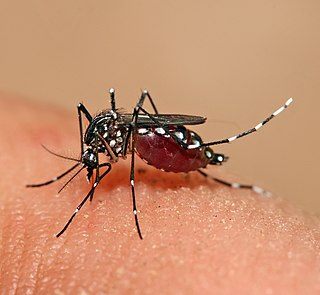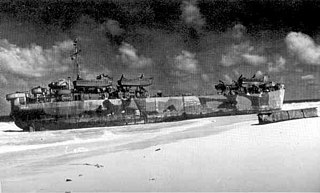Related Research Articles

Parasitism is a close relationship between species, where one organism, the parasite, lives on or inside another organism, the host, causing it some harm, and is adapted structurally to this way of life. The entomologist E. O. Wilson characterised parasites as "predators that eat prey in units of less than one". Parasites include single-celled protozoans such as the agents of malaria, sleeping sickness, and amoebic dysentery; animals such as hookworms, lice, mosquitoes, and vampire bats; fungi such as honey fungus and the agents of ringworm; and plants such as mistletoe, dodder, and the broomrapes.

The Mallophaga are a possibly paraphyletic section of lice, known as chewing lice, biting lice, or bird lice, containing more than 3000 species. These lice are external parasites that feed mainly on birds, although some species also feed on mammals. They infest both domestic and wild mammals and birds, and cause considerable irritation to their hosts. They have paurometabolis or incomplete metamorphosis.

In biology and medicine, a host is a larger organism that harbours a smaller organism; whether a parasitic, a mutualistic, or a commensalist guest (symbiont). The guest is typically provided with nourishment and shelter. Examples include animals playing host to parasitic worms, cells harbouring pathogenic (disease-causing) viruses, or a bean plant hosting mutualistic (helpful) nitrogen-fixing bacteria. More specifically in botany, a host plant supplies food resources to micropredators, which have an evolutionarily stable relationship with their hosts similar to ectoparasitism. The host range is the collection of hosts that an organism can use as a partner.

Plasmodium is a genus of unicellular eukaryotes that are obligate parasites of vertebrates and insects. The life cycles of Plasmodium species involve development in a blood-feeding insect host which then injects parasites into a vertebrate host during a blood meal. Parasites grow within a vertebrate body tissue before entering the bloodstream to infect red blood cells. The ensuing destruction of host red blood cells can result in malaria. During this infection, some parasites are picked up by a blood-feeding insect, continuing the life cycle.

Aedes is a genus of mosquitoes originally found in tropical and subtropical zones, but now found on all continents except Antarctica. Some species have been spread by human activity: Aedes albopictus, a particularly invasive species, was spread to the Americas, including the United States, in the 1980s, by the used-tire trade.

Parasitology is the study of parasites, their hosts, and the relationship between them. As a biological discipline, the scope of parasitology is not determined by the organism or environment in question but by their way of life. This means it forms a synthesis of other disciplines, and draws on techniques from fields such as cell biology, bioinformatics, biochemistry, molecular biology, immunology, genetics, evolution and ecology.

Brood parasitism is a subclass of parasitism and phenomenon and behavioural pattern of certain animals, brood parasites, that rely on others to raise their young. The strategy appears among birds, insects and fish. The brood parasite manipulates a host, either of the same or of another species, to raise its young as if it were its own, usually using egg mimicry, with eggs that resemble the host's.

The Molidae comprise the family of the molas or ocean sunfishes, unusual fish whose bodies come to an end just behind the dorsal and anal fins, giving them a "half-fish" appearance. They are also the largest of the ray-finned bony fish, with the southern sunfish, Mola alexandrini, recorded at 4.6 m (15 ft) in length and 2,744 kg (6,049 lb) in weight.
Parasite is the name of several supervillains appearing in American comic books published by DC Comics. Each iteration of the character has the ability to temporarily absorb the life force, attributes, memories, and superpowers of anyone through physical touch. The most well-known and recurring incarnation is Rudy Jones, who has become one of Superman's most enduring enemies and belongs to the collective of adversaries that make up his rogues gallery. In 2009, Parasite was ranked as IGN's 61st Greatest Comic Book Villain of All Time.
The Ascetosporea are a group of eukaryotes that are parasites of animals, especially marine invertebrates. The two groups, the haplosporids and paramyxids, are not particularly similar morphologically, but consistently group together on molecular trees, which place them near the base of the Cercozoa. Both produce spores without the complex structures found in similar groups.

Bong Joon-ho is a South Korean film director, producer and screenwriter. The recipient of three Academy Awards, his filmography is characterised by emphasis on social and class themes, genre-mixing, black humor, and sudden tone shifts.

Avian malaria is a parasitic disease of birds, caused by parasite species belonging to the genera Plasmodium and Hemoproteus. The disease is transmitted by a dipteran vector including mosquitoes in the case of Plasmodium parasites and biting midges for Hemoproteus. The range of symptoms and effects of the parasite on its bird hosts is very wide, from asymptomatic cases to drastic population declines due to the disease, as is the case of the Hawaiian honeycreepers. The diversity of parasites is large, as it is estimated that there are approximately as many parasites as there are species of hosts. As research on human malaria parasites became difficult, Dr. Ross studied avian malaria parasites. Co-speciation and host switching events have contributed to the broad range of hosts that these parasites can infect, causing avian malaria to be a widespread global disease, found everywhere except Antarctica.

USS LST-563 was an LST-542-class tank landing ship built for the United States Navy during World War II. She was in commission during 1944.

Urobatis maculatus, known as the spotted round ray or Cortez round stingray, is a species of round ray, within the genus Urobatis, and of the family Urotrygonidae. It is endemic to Mexico, with its natural habitats being shallow seas, subtidal aquatic beds, coral reefs, estuarine waters, intertidal marshes, and coastal saline lagoons.

Like humans and other animals, fish suffer from diseases and parasites. Fish defences against disease are specific and non-specific. Non-specific defences include skin and scales, as well as the mucus layer secreted by the epidermis that traps microorganisms and inhibits their growth. If pathogens breach these defences, fish can develop inflammatory responses that increase the flow of blood to infected areas and deliver white blood cells that attempt to destroy the pathogens.
German submarine U-563 was a Type VIIC U-boat of Nazi Germany's Kriegsmarine during World War II. She carried out eight patrols and sank three ships, totalling 14,689 gross register tons (GRT), as well as one warship of 1,870 tons. Two ships were damaged, totalling 16,266 GRT. She was a member of nine wolfpacks, and was sunk by Allied aircraft in the Bay of Biscay on 31 May 1943.
Euzetia lamothei is a flatworm which parasitizes the gills of the cownose ray. It is named after Dr. Marcos Rafael Lamothe Argumedo, a professor at Universidad Nacional Autónoma de México who has done research on Monogeneans. The species averages 405 micrometers long by 178 micrometers wide. It can be distinguished from its closest relative, Euzetia occultum, based on size and the morphology of the reproductive organs.

Parasite is a 2019 South Korean black comedy thriller film directed by Bong Joon-ho, who co-wrote the screenplay with Han Jin-won and co-produced. The film, starring Song Kang-ho, Lee Sun-kyun, Cho Yeo-jeong, Choi Woo-shik, Park So-dam, Jang Hye-jin, Park Myung-hoon, and Lee Jung-eun, follows a poor family who infiltrate a wealthy family.
National Highway 563 is a National Highway in India. Total length 248.83(154.62mi). It passes through the districts of Jagtial, Karimnagar, Warangal and Khammam in Telangana state. The Karimnagar Cable Bridge is on the route and shortened the distance to Warangal by 7km.
References
- ↑ Merlo-Serna, Aldo Iván; García-Prieto, Luis (15 Feb 2016). "A checklist of helminth parasites of Elasmobranchii in Mexico". ZooKeys (563): 73–128. Bibcode:2016ZooK..563...73M. doi: 10.3897/zookeys.563.6067 . PMC 4797213 . PMID 27047240.